Book Reviews 5
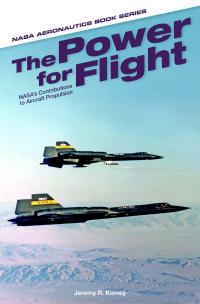 |
The Power for Flight
NASA’s Contribution to Aircraft Propulsion
by Jeremy R. Kinney
6.25" x 9.5", 316 pages
ISBN 9781626830387 (Epub)
ISBN 9781626830370 (hardcover)
ISBN 9781626830394 (softcover)
National Aeronautics and Space Administration (2017)
B/W, Color Photographs
Recommended Retail Price: Epub is FREE!! |
Reviewed by Kimble D. McCutcheon
This work surveys the aircraft propulsion contributions of The National Aeronautics and Space Administration (NASA), and of its predecessor The National Advisory Committee on Aeronautics (NACA). It primarily addresses work at four NASA centers, the Langley Research Center in Virginia, the Glenn Research Center at Lewis Field in Ohio, the Ames Research Center in California, and the Armstrong Flight Research Center in California. Glenn, NASA’s primary propulsion facility, includes five wind tunnels, the Aero-Acoustic Propulsion Laboratory, the Engine Research Building, the Propulsion Systems Laboratory, and the Flight Research Building. NASA specialists work with the military, industry and academia to create and advance breakthrough aerospace technologies.
The NACA, from its creation in 1915 until it became NASA in 1958, was dedicated to the piston engine–propeller combination and the early turbojet revolution. Among its many accomplishments, the NACA did pioneering work in propeller theory, engine cooling, fuels and engine/airframe integration.
NASA supported the development of high-speed military aircraft flight and commercial subsonic flight during the 1960s and 1970s. It also studied commercial supersonic transport and helped improve reciprocating, turbofan, turboprop and turboshaft performance and fuel efficiency while reducing pollution and noise. NASA contributed extensively to the development of digital engine controls, thrust vectoring and electric aircraft.
As one might surmise, a book that chronicles 100 years of aviation technical history cannot treat it in any great depth. However, The Power for Flight is extensively documented, and much of its rich source collection is available online. In addition, there is a bibliography, an abbreviation list and an extensive index. This is a work that anyone interested in the history of American aircraft propulsion should have.
 |
Arsenal of Democracy
The American Automobile Industry in World War II
by Charles K. Hyde
Hardbound, 7.2" x 10" x 0.8", 264 pages
ISBN-13: 978-0814339-510
Wayne State University Press (1 October 2013)
Recommended Retail Price: $39.95
34 illustrations |
Reviewed by Carl Kuhns - 17 Jun 2016
This book details the role that Detroit’s automobile manufacturers played in World War II materiel production. The auto companies made aircraft engines, propellers, complete aircraft, aircraft components, tracked vehicles, wheeled vehicles, and munitions. Being an aircraft engine enthusiast, I was particularly interested in the sections concerning aircraft engines and propellers.
Wright Aeronautical Corporation licensed two auto companies to make two models of their engines. The Studebaker Corporation produced the R-1820 for the B-17 and Dodge-Chicago manufactured the R-3350 for the B-29.
Pratt & Whitney licensed its engines to the following automobile companies: Ford (R-2800); Buick (R-1830); Chevrolet (R-1830, R-2800); Nash-Kelvinator (R-2800).
Allison, a General Motors division, made aircraft engines before and during the war. Packard Motor Car Company built the Rolls-Royce Merlin liquid cooled V-12 engines.
The most impressive production was auto maker Nash-Kelvinator’s production of 158,134 Hamilton Standard propellers.
Also mentioned in Arsenal of Democracy were the manufacture of complete aircraft by three auto companies. Ford built B-24s at the Willow Run, Michigan and Waco-designed wood gliders in Iron Mountain, Michigan. Eastern Aircraft, a division of the General Motors Corporation, built Grumman Avenger torpedo bombers and Wildcat Fighters. Nash-Kelvinator completed 262 Sikorsky R-6 helicopters.
I was interested to read about two men who played a prominent role in World War II war production. William S. Knudsen had a long career as an auto industry executive, first with Ford and later with General Motors. He resigned his position as president of General Motors in 1940. Franklin Delano Roosevelt appointed him as Director of War Production. Albert Kahn was the foremost American industrial architect from the 1900s to the 1940s. Kahn’s architectural firm designed the massive 6,430,000 square foot floor space Dodge-Chicago B-29 engine plant. Albert Kahn also designed the Willow Run B-24 plant. It consisted of an L-shaped building with 4,734,617 square feet of floor space. Interesting enough, both Kahn and Knudsen were immigrants to America. Knudsen was born in Denmark; Kahn was born in Germany.
I did notice some misinformation in the section concerning Buick-built Pratt & Whitney engines. The author states that Buick built Pratt & Whitney R-2800s for the C-54 cargo plane. I have never seen any other reference that anything but Pratt & Whitney R-2000s powered C-54s.
 |
The Electra Story
by Robert Sterling
Softcover, 6.9" x 4.2" x 0.6", 171 pages
ISBN-13: 978-0553288452
Bantam Air & Space Series No. 9 (1991 )
Used Price: ~$27.95
B/W illustrations |
Reviewed by Tom Fey - 16 August 2014
While at the Oshkosh Fly Market last month, I found a hardcopy edition of Robert J. Serling’s The Electra Story: Aviation’s Greatest Mystery. First published in 1963, the book looked like a great read, but at $45, not in the budget. Amazon.com has used copies, both hardback and the paperback edition printed by Bantam in 1991, for $27 on up. My local library did not have a copy, but I was able to obtain a copy via Inter Library Loan for free. The book was well worth chasing down.
The Lockheed L-188 Electra was the first American 4-engine turboprop commercial transport. It first flew in late 1957, entered into airline service in January 1959, and was claimed by Lockheed President Robert Gross to be the most rigorously tested aircraft in history.
However, two fatal crashes, six months apart, both due to wing separation while in cruise flight, severely tested the CAB, FAA, NASA, Lockheed, Allison, and Congress, as well as the entire commercial aircraft and airline industry. The author does a fantastic job describing the building and testing of the Electra, its entry into service, the accidents, the politics, the theories, and the compelling hunt for the truth of what happened and why on the two primary accidents as well as subsequent incidents. The resulting airframe remedies are explained in worthwhile detail and are accompanied by several drawings. But for me, the narrative of how and where the corrected Electra was flown to prove her new-found integrity is almost beyond belief and would certainly never be allowed today.
At only 171 pages in the paperback, I highly recommend first reading the book, and then take a look at the video linked below which reproduces, at 1/8th scale, the known, but completely unexpected, phenomenon that downed the Electra. It is a fascinating story.
http://www.youtube.com/watch?v=d0fFNWANK5M
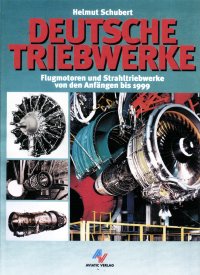 |
Deutsch Triebwerke
3rd edition
by Helmut Schubert
Hardbound, 30cm X 23cm (A4), 178 pages
ISBN No. 3-925505-49-0
Aviatic Verlag-GmbH, Germany, 1999
Profusely illustrated, many pictures in colour
German language text
Price (March 30, 2006): €34.90 from www.amazon.de
For help, click "Hilfe" and see
"Information for English speaking customers"
|
Reviewed by Jerry Wells
The main features of this book are outstanding quality and
excellent value. Every page is printed on top quality, glossy paper and the
photo reproduction is very good (i.e., non-digital). Plainly, the book is backed
and subsidized by the giant M.T.U. aerospace corporation based in Munich. A book
of this quality would normally retail at double the price being asked.
Helmut Schubert is an experienced aero-engine author, he
being one of the trio that wrote the definitive "Flugmoteren and Stahitriebwerke"
some time ago. This book covers aero-engine development in Germany from the
first Zeppelins through to production in 1997. It is not all embracing but
rather, it details some interesting aspects as seen by the author.
The first 50 or so pages deal with piston engine
development—most of the usual suspects are covered, e.g., BMW, Siemens,
Daimler-Benz and M.A.N.
Pages 51 to 70 provide an intriguing review of German WWII
gas turbines with some previously unpublished photos and drawings pertaining to
the period.
The final 100 or so pages detail the design, development
and manufacture of gas turbines in West Germany from the 1950s onwards. The
story starts with the little BMW 6012 helicopter engine which was an indigenous
creation. From then on, practically all German aero-engine production has been
based on collaborative projects with Canadian, British and American companies
resulting in production of such engines as the GE J79, R-R RB 199, P&W 2037 and
the IAE V2500. Colour photos abound in this section.
At the back of the book, there is a four page, "Main
Events" summary starting at 1888 and going through to 1999.
Conclusion: A beautifully presented aero-engine book
available at a very reasonable price.
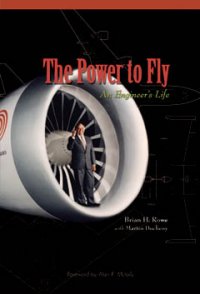 |
Power To Fly
An Engineer's Life
Brian H. Rowe with Martin Ducheny
American Institute of Aeronautics and Astronautics Inc., 2005
ISBN 1-56347-709-2
Hardbound (dust jacket), 23cm X 15cm, 205 pages
List Price (March 30, 2006): US $39.95
40 black & white illustrations
|
Reviewed by Jerry Wells
This book is the second one with the title, The Power to
Fly that I have inducted into my library, the first being the highly
entertaining 1971 work by L.J.K. Setright. Also, it is the third book I have
read in recent times written by an executive of the General Electric Company,
the other two being the recently republished, Herman the German by
Gerhard Neumann and Starting Something Big by Bob Garvin. Neumann's book
has only 4 (of 20) chapters devoted to his time at GE, whereas, Garvin's work is
all about the GE aero-engine business.
At first glance, The Power to Fly appears to be a
conventional case-bound book but, in fact, it is a hard-cover paper back, known
in the trade as a "cardboard article"—not as good as a hardbound publication but
quite sturdy, none the less. If opened and laid flat the book will spring shut.
The dust cover is rather strange in that it has a black background with a jet
engine which has the author standing in the intake using the well-known
finger-in-the-air gesture to indicate that GE is "number one", but this could
easily be misunderstood! Apart from this, the cover is dull. This book is
presented in 18 chapters but is somewhat unusual in that each chapter is
subdivided by use of headings. These range in number from two to twelve. Perhaps
it's the sort of tidy logic to be expected from an engineer!
Brian Rowe was born in England and upon leaving school,
took up an apprenticeship at the deHavilland Company. After nine years there, he
applied for a job with GE. All this is compressed into the first chapter. The
following 18 chapters are purely about America and GE. Of the co-author, Martin
Ducheny, we are told absolutely nothing which is a pity because it seems rather
odd that the president of GE engines should need anyone to help him write a
book.
Chapters 2 to 7 give a potted history of GE gas turbine
engines from the 1950s through to the 1980s. Brian Rowe's first job at GE was to
develop the lift-fan engine which was eventually tested in the little T-tailed
Ryan XV-5A aircraft. He holds the patent for the design.
Chapters 8 to 12 move away from technical matters and deal
more with aspects of management. Rowe's capacity for organizing programs and
working with people was considerable as evidenced by his rapid rise through the
ranks of GE.
In Chapter 13 he gets back to technical matters and
describes the conception and development of the huge GE90 turbo-fan engine—a
project with which he was closely associated and one which meant a lot to him.
The GE90 had its first flight in a Boeing 777 in February 1995 just after he had
retired. What he has to say about the launching of the GE90 is most interesting.
The remaining five chapters ramble through his
post-retirement life which was fairly predictable—serving on Boards of
Companies, building houses and enjoying just about everything money can buy.
After 35 years at a company like GE, most of them at, or near the top, Brian
Rowe would have retired a very wealthy man.
In summary, this book is a good read. What spoils it
somewhat is that the text is not only small but also quite faint. Sure, it is
readable but I doubt that many people would find it comfortable reading,
especially those in the older age group. This is a great contrast to Bob
Garvin's book (also from the AIAA) which has good sized, clear print making it a
very "reader friendly" piece of literature.
The Power to Fly has 40 illustrations. Many of the
photos are derived from coloured originals and suffer in quality because of it.
No fewer than 12 of the pictures feature Brian, including one of B.H.R. and a
business acquaintance sunbathing on a beach—not a very efficacious sight!
However, with the publication of this book, we now have accounts of aero-engine
development at General Electric from three GE executives, namely Neumann, Garvin
and Rowe, so the events are well documented.
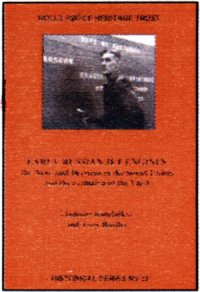 |
Early Russian Jet Engines
by Vladimir Kotelnikov & Buttler
Soft Cover, 21cm x 14cm (A5), 116 pages
Rolls-Royce Heritage Trust (2003)
Price: NZ $43.00 (+p&p)
134 illustrations 21 coloured)
|
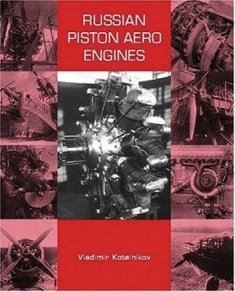 |
Russian Piston Aero Engines
by Vladimir Kotelnikov
Hard Cover (dust jacket) 28cm x 22cm (A4),270 pages
Crowood Press, UK. 2005
Price: NZ $110.00 (+p&p)
470 illustrations, all Black & White
|
Review by Jerry Wells
These two books by Russian
author, Vladimir Kotelnikov provide new pieces in the jigsaw that is aero-engine
history and, as such, they are most welcome. Kotelnikov has chosen to publish
his works in English and both books have been printed in the UK.
Early Russian Jet
Engines starts with a survey by
Kotelnikov of the first Soviet turbo-jet engines during the period 1937-39. The
second chapter describes the application of captured German technology after
WWII and this is followed by an account of how British know-how was gained
(quite a lot of it by stealth!). Chapter 4 is contributed by Buttler and
describes the political difficulties that beset Rolls-Royce in their attempt to
sell jet-engines to the Soviet Union.
In the final two chapters,
Kotelnikov covers the production of the Rolls-Royce Nene and Derwent copies by
various Russian factories. His description of the origin and manufacture of the
VK-1 differs markedly from that given by Bill Gunston in his Aero-Engines
(1986).
Likes:
1) Attractive cover - gold writing on bright red background.
2) Good sized, clear print on good quality paper.
3) Coloured pictures of early Russian jets are nice.
Dislikes:
1) Small page size severely limits photo and drawing presentation.
2) Tight spine binding is "reader unfriendly".
3) Engine photos and drawings too small.
4) Too many aircraft photos.
5) Too many blank spaces throughout the text.
Conclusion: Worth buying, lots of new info.
Russian Piston Aero
Engines gives a complete and
comprehensive overview of all the piston aircraft engines ever used, copied or
manufactured in the Soviet Union. Part 1, (20 of 270 pages) is concerned with
history and background - such things as State control, central organization,
factories, testing and military requirements. Part 2 gets down to the business
of classifying and describing the huge variety of engines deployed by the
U.S.S.R. from 1917 to the present day. In the Soviet-style command-economy,
there were no independent engine manufacturing companies that are familiar in
the West so types of engines tended to be associated with designers such as
Klimov or Mikulin and this is the basis for much of the grouping in this book.
Mr. Kotelnikov, who was
born in Moscow in 1951, obviously has a very good command of the English
language but with a technical work such as this, a review of the text prior to
publication by someone who a) has a fair knowledge of the subject and b) has
English as their first language, is essential. This hasn't happened and, as a
result, some extraordinary statements occur, e.g., "The engine had a crankshaft
on roller bearings with lug suspension..." or "...the cylinders had spherical
bottoms (an alternative conical version also existed) and were screwed into the
block." Perhaps the A.E.H.S. should offer a review service to get the
"translation bugs" out of new books of this kind. The same problem of irritating
mis-translation occurs in the recently published Hispano-Suiza book.
My biggest criticism is
directed at the size and reproduction quality of the engine photos and line
drawings. The majority are too small, badly composed, fuzzy and/or unclear. What
is really sad, is that the recently shot museum-engine photos (and there are
many of these) are of no better quality than archival pictures from the 1920s! I
also feel there are too many gratuitous photos of aircraft which, if omitted
would have allowed space for some decent sized engine images.
At the back of the book
there is an appendix of 36 tables which summarizes the characteristics of all
the engines described in the book.
Likes:
1) Beautifully presented book - big,
glossy pages, hard cover, good binding (attributes not fully exploited by the
production team).
2) Terrific round-up and clarification of a complex piece of aero-engine
history.
Dislikes:
1) Complete lack of colour graphics.
2) Poor quality engine photos.
3) Poor line drawings.
4) Irritating mis-translation.
Conclusion: An essential reference book.
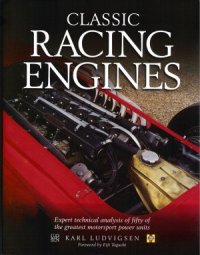 |
Classic Racing Engines
by Karl Ludvigsen
Haynes
Publishing, Somerset, UK, March 2001
Available from Motorbooks International
|
Review by Doug Culy
Classic Racing Engines
presents the fruits of many years of Ludvigsen's talking to people involved in
racing engine development from 1913 to 1994, and packs stories of 50 engines
into four pages on each, with many photos, cutaways and cross-sections. There
are V- and H-16s, I-4s, as well as V- and I-8s, -6s, and V-12s. DOHC, SOHC,
pushrod, and desmodromic engines are there. Ludvigsen gives for many of these
the evolution of design and many, many details that uniquely define each
manufacturer's approach to engine design. This is a very satisfying book, and a
must for even aircraft engine enthusiasts.







